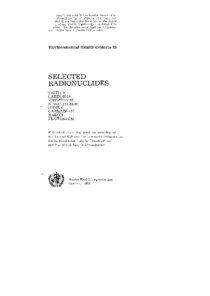Selected radionuclides : Tritium, Carbon-14, Krypton-85, Strontium-90, Iodine, Caesium 137, Radon, Plutonium

World Health Organization ; UN. Environment Programme
WHO - Geneva
1983
237 p.
dose response relationship ; dosimetry ; environmental pollution ; genetic effects ; ionising radiation ; permissible radiation doses ; radiation injury ; radioactive substances ; risk assessment ; routes of entry ; standard
Environmental Health Criteria
25
Chemicals
English
Bibliogr.;Charts
92-4-154085-0
In this report the more general considerations of environmental behaviour of several radionuclides are discussed, including sources, transport to man and dosimetry. The radionuclides discussed are those most frequently released from natural and man-made sources and the greatest contributors to population radiation exposure under normal circumstances. Radionuclides are a special class of environmental substances. They are the unstable configurations of chemical elements which undergo radioactive decay, emitting radiation in the form of alpha or beta particles and x or gamma rays.
Digital
The ETUI is co-funded by the European Union. Views and opinions expressed are however those of the author(s) only and do not necessarily reflect those of the European Union or the ETUI.